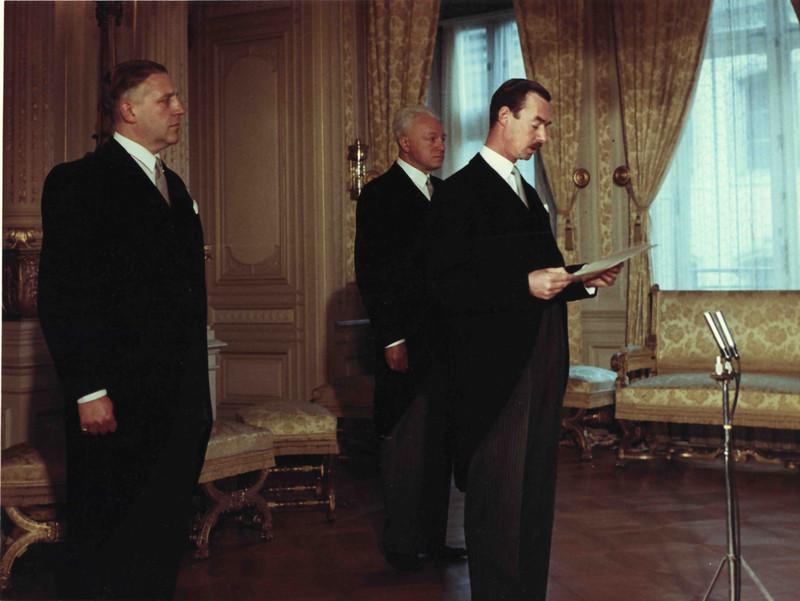The Constitutional Monarchy




In a hereditary monarchy, the monarch does not exist alone: he is part of a family, known as a dynasty. This family plays an important role in ensuring the continuity of the monarchy and in performing certain functions of public interest.
(All articles referenced on this page refer to the articles of the Constitution of the Grand Duchy of Luxembourg that came into force on 01/07/2023.)

© Maison du Grand-Duc / Sophie Margue & Kary Barthelmey
Besides the Grand Duke himself, other members of the family may also serve the State, even if only in a symbolic or occasional capacity. The Constitution (Art. 54) provides a state allowance solely for the Grand Duke, and, where applicable, for:
The Constitution (Art. 54) provides a state allowance solely for the Grand Duke, and, where applicable, for:
- the former Head of State,
- the Hereditary Grand Duke,
- the Regent and
- the Lieutenant-Représentant.
The Order of Succession
The position of Head of State is hereditary (Art. 56). It passes to the direct descendants of the first Grand Duke of the Nassau-Weilburg line, Adolphe, according to the principle of primogeniture (the firstborn child, regardless of gender) and by representation (within the line of succession). Only children born in wedlock have the right to succeed to the throne.

© Maison du Grand-Duc / Christian Aschman
Currently, the line of succession to the throne is secured by Prince Charles. His brother, Prince François, is second in line of succession. Tradition in Luxembourg holds that the reigning Grand Duke chooses the appropriate moment to abdicate in favour of his heir.
A brief history of the order of succession:
The Nassau Family Pact establishes the order of succession in the direct male line according to the principle of primogeniture. In the absence of male descendants, the crown passes to the eldest daughter of the ruling dynasty.
At the Congress of Vienna, the Duchy of Luxembourg enters into a personal union with the newly created United Kingdom of the Netherlands under William I, Prince of Orange-Nassau, and is elevated to a Grand Duchy.
The Treaty of London ends the Prussian-French crisis over Luxembourg. The Grand Duchy is declared perpetually neutral, and the rights of the House of Nassau’s descendants are confirmed.
Grand Duke William IV has six daughters. He issues a new family statute allowing his daughters to inherit the throne in the absence of male heirs. Princess Marie-Adélaïde is declared heir presumptive.
Grand Duke Henri introduces an absolute primogeniture, ensuring equality between men and women’ in the line of succession to the throne.
The Hereditary Grand Duke
Once the heir presumptive reaches the age of 18, they receive the title ‘Hereditary Grand Duke of Luxembourg’. The term ‘heir’ refers to a status acquired at birth, essential for one day ascending to the throne. Neither this status nor the title of heir makes the person a constitutional organ of the state. They are considered the future Head of State; their assumption of office is probable, but not guaranteed.

© Maison du Grand-Duc / Sophie Margue & Kary Barthelmey
Only upon being appointed as Lieutenant-Représentant does the heir officially hold a state office, since he participates in the role of the Grand Duke.
In practice, starting after completing his studies, the Hereditary Grand Duke plays an active role in supporting the Grand Duke in official duties. In recent decades, it has become customary for the heir to be involved in promoting Luxembourg’s economy abroad and to partake in activities of societal relevance. Upon appointment as Hereditary Grand Duke, he may be appointed by the Grand Duke as a member of the Council of State, allowing him to deepen his understanding of the legislative workings of the State.
The Role of the Spouse

© Maison du Grand-Duc / Christian Aschman
Regardless of gender, the role of the spouse of the Grand Duke remains the same: they participate in the upbringing of the children and in official and ceremonial duties. Additionally, the spouse may become involved in charitable, social and artistic causes.
Although often discreet, this role plays an important part in maintaining the symbolic and institutional continuity of the monarchy.
The former Head of State

© Maison du Grand-Duc / Sophie Margue
The parents of the reigning Grand Duke continue, in practice, to hold their titles.
For example, former Grand Duke Jean retained his title after his abdication. This is a ceremonial and symbolic custom without any institutional role.
The former Head of State may still participate in public life and engage in charitable or civic initiatives, in coordination with the reigning Grand Duke.
Representation of the Grand Duke
There may be times when the Head of State needs to be represented, for various reasons. Two different mechanisms ensure the continuity of the office, even in cases of temporary or permanent impediment of the Grand Duke.
The Lieutenance
As the position of Head of State in the Grand Duchy of Luxembourg is hereditary, the Grand Duke may choose to be represented by another adult family member (Art. 58), who is in the line of succession (Art. 56). This person is appointed ‘Lieutenant-Représentant of the Grand Duke’ and assumes office after taking the oath before the Chamber of Deputies.
Today, the Lieutenancy is considered the final stage of preparation for the Hereditary Grand Duke before assuming the role of Head of State.
A brief history of Lieutenancies
There have been six lieutenancies – of various durations – in the history of the Grand Duchy:
Prince Henry of the Netherlands is appointed by his brother, King Grand Duke William III, on 5 February 1850. The Lieutenance lasts until Prince Henry’s death in 1879.
Prince William of Nassau is appointed by his father, Grand Duke Adolphe, then aged 85. When Adolphe dies in November 1905, Prince Wiliam becomes Grand Duke William IV.
Due to poor health, Grand Duke William IV appoints his wife, Grand Duchess Maria Anna, as Lieutenant-Représentant in March 1908. In November, the Lieutenance is replaced by a Regency.
Grand Duchess Charlotte appoints Prince Jean as Lieutenant-Représentant in April. She abdicates in November 1964 in favor of Grand Duke Jean.
Hereditary Grand Duke Henri is appointed by Grand Duke Jean in March 1998. Jean abdicates in October 2000, and Henri becomes Grand Duke.
Hereditary Grand Duke Guillaume takes the oath before the Chamber of Deputies and becomes Lieutenant-Représentant of Grand Duke Henri. It is the first time the oath is taken in the Chamber under the Constitution of July 2023. Grand Duke Henri hands over the throne to Grand Duke Guillaume V on 3 October 2025.

H.R.H. Crown Prince Jean of Luxembourg during the official swearing-in ceremony as Lieutenant-Représentant of his mother, H.R.H. Grand Duchess Charlotte.
© Collection Cour grand-ducale

Swearing-in ceremony of H.R.H. Crown Prince Henri of Luxembourg as Lieutenant-Représentant of Grand Duke Jean.
© Collection Cour grand-ducale / SIP

© Maison du Grand-Duc / Kary Barthelmey
The Regency
A Regent assumes the role of Grand Duke when the latter is unable to fulfil his duties (Art. 59). The Grand Duke retains his title but no longer exercises his functions. Another adult family member, who is in the line of succession (Art. 56), then takes over temporarily. The Regent must take the oath before the Chamber of Deputies.
A regency is required:
- when the successor is a minor at the time of the Grand Duke’s death or abdication. The regency lasts until the successor reaches adulthood. Or
- if the Grand Duke is temporarily unable to fulfil his constitutional duties, for example due to health reasons.
A brief history of Regencies
There have been two Regents (and four Regencies) in Luxembourg’s history:
Two regencies by Duke Adolphe of Nassau, later Grand Duke of Luxembourg, at the end of William III’s reign.
Two regencies by Grand Duchess Maria Anna, wife of Grand Duke William IV. The first during his illness until 1912, the second between his death on 25 February 1912 and the majority of Marie-Adélaïde on 14 June 1912.

Swearing-in of Duke Adolphe of Nassau as Duke-Regent.
© Collection Cour grand-ducale
Conclusion
The role of the Grand Duke is firmly rooted in the Constitution of the Grand Duchy and reflects a balance between tradition and modern democracy. As Head of State, the Grand Duke embodies national unity, state continuity and independence. His duties are defined and always embedded within a system of parliamentary oversight.
Luxembourg’s constitutional monarchy demonstrates how a monarchical head of state can function within a democratic framework, respecting the separation of powers, political neutrality and a stable institutional foundation.
Learn more
Accessibility settings
Search












